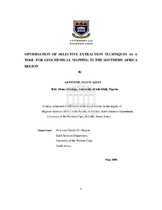| dc.contributor.advisor | Okujeni, Charles | |
| dc.contributor.author | Akinyemi, Segun Ajayi | |
| dc.contributor.other | Dept. of Earth Science | |
| dc.contributor.other | Faculty of Science | |
| dc.date.accessioned | 2013-11-26T18:18:56Z | |
| dc.date.available | 2009/12/11 10:47 | |
| dc.date.available | 2009/12/11 | |
| dc.date.available | 2013-11-26T18:18:56Z | |
| dc.date.issued | 2008 | |
| dc.identifier.uri | http://hdl.handle.net/11394/2463 | |
| dc.description | Magister Scientiae - MSc | en_US |
| dc.description.abstract | The complex nature and composition of regolith cover in Southern Africa is a major challenge to geochemical mapping for concealed mineralization. Some of the setbacks to successful geochemical exploration may be ascribed to the use of various partial extraction techniques,without a profound understanding of the regolith components and their composition. This investigation therefore focuses on the use of hydroxylamine partial extraction geochemistry for geochemical mapping in regolith over two contrasting environments viz; aeolian sand-calcrete regolith over Au mineralization at Amalia Blue Dot Mine in South Africa and lateritic regolith covering the Ni-Cu deposit at Kabanga Main and Luhuma in Tanzania. Regolith samples from the above areas were sieved and extracted with hydroxylamine hydrochloride solution and analyzed for multi-element by AAS and ICP-MS techniques. A stepwise optimization of the hydroxylamine extraction technique of samples from both areas was carried out and incorporated into the analytical programme (in a pilot study). Results of hydroxylamine partial extraction generally gave better anomaly contrast and reflection of bedrock mineralization than the conventional aqua regia techniques that were previously used in the region. The results however show that lateritic regolith may be best extracted using 0.25M hydroxylamine while 0.1M concentration appears most suitable for extraction of aeolian-calcrete regolith. The above results are corroborated by principal component analysis of the analytical data that show various element associations, e.g. with Fe-Mn oxides while others possibly belong to the loosely adsorbed or exchangeable group. The gochemical maps in the pilot study areas at Amalia, Kabanga and Luhuma show elevated element contents or clusters of anomalies of diverse elements associated with Fe-Mn oxides. Geochemical mapping at Kabanga with deeply concealed mineralization however shows variability of subdued element patterns over mineralized areas. Geochemical signatures associated with hydroxylamine hydrochloride partial leach are therefore characterized by a lower geochemical background than that using conventional aqua regia leach. This study leads recommending for further investigations into partial extraction of the exchangeable group of elements, possibly using ammonium acetate. | en_US |
| dc.language.iso | en | en_US |
| dc.publisher | University of the Western Cape | en_US |
| dc.subject | Geochemical mapping | en_US |
| dc.subject | Regolith cover | en_US |
| dc.subject | Hydroxylamine | en_US |
| dc.subject | Aeolian sand-calcrete | en_US |
| dc.subject | Lateritic | en_US |
| dc.title | Optimisation of selective extraction techniques as a tool for geochemical mapping in the Southern Africa region | en_US |
| dc.type | Thesis | en_US |
| dc.rights.holder | University of the Western Cape | en_US |
| dc.description.country | South Africa | |

